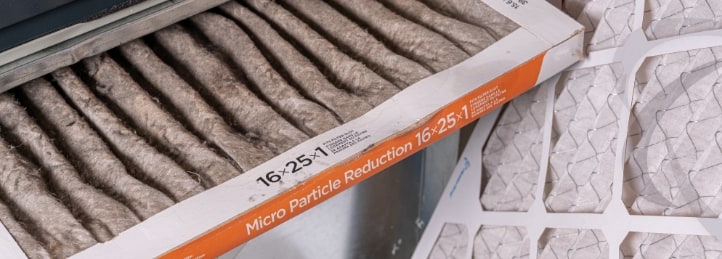Indoor Air Quality Services in Shreveport, LA

Since 1971, Moon's Air has been committed to providing whole-home comfort, including improving the indoor air quality of homes in Shreveport, LA. The air inside your home plays a crucial role in your family’s health, comfort, and overall well-being. Poor indoor air quality can lead to allergies, respiratory issues, and even long-term health concerns. Our team of NATE-certified technicians specializes in air purification, filtration, humidity control, and ventilation solutions to ensure your home’s air is clean and safe.
- Providing Whole Home Comfort Since 1971
With decades of experience, we understand the importance of indoor air quality and offer comprehensive solutions tailored to your needs. - NATE-Certified Technicians
Our expert team undergoes extensive training to stay up to date with the latest air quality technologies and best practices. - 100% Satisfaction Guarantee
Your satisfaction is our top priority. We ensure that every indoor air quality solution we provide meets the highest standards of performance and reliability. - A+ Rating by the BBB
Our dedication to superior service and customer satisfaction has earned us an A+ rating with the Better Business Bureau. - Lennox Premier Dealer
As a Lennox Premier Dealer, we offer industry-leading air quality products that improve comfort, efficiency, and air purity in your home.
As a Lennox Premier Dealer with an A+ rating from the Better Business Bureau, Moon's Air is dedicated to delivering top-tier indoor air quality solutions. We stand behind our work with a 100% satisfaction guarantee, ensuring that your home remains a healthy environment for you and your loved ones.

Expert Knowledge and Trusted Solutions
Our team understands the factors that affect indoor air quality and how to address them effectively. From airborne contaminants to humidity control, we provide tailored solutions that ensure cleaner, healthier air in your home.
Advanced Air Filtration and Purification
We offer cutting-edge air filtration systems, including HEPA filters, UV germicidal lights, and whole-home air purifiers. These systems remove dust, allergens, bacteria, and airborne pollutants, creating a healthier living environment.
Humidity Control for Maximum Comfort
Balancing humidity levels is key to maintaining comfort and preventing mold growth. Our humidifiers and dehumidifiers work seamlessly with your HVAC system to keep indoor moisture at an optimal level.
Ventilation Solutions for Fresh Air Circulation
Proper ventilation helps remove stale air and bring in fresh outdoor air. Our energy recovery ventilators (ERVs) and heat recovery ventilators (HRVs) improve air circulation without compromising energy efficiency.
Custom Solutions for Every Home
Every home has different air quality needs. We perform in-depth assessments to identify specific concerns and recommend customized solutions that fit your lifestyle and budget.
Ensuring clean indoor air is essential for a healthier home. With Moon's Air, you can trust that our expertise, high-quality products, and customer-focused approach will provide you with the best indoor air quality solutions available. Contact us today to schedule an air quality consultation and start breathing easier!
When to Consider an Air Purification System
If you or your family suffer from allergies, asthma, or frequent respiratory issues, poor indoor air quality could be the culprit. Airborne contaminants like dust, pet dander, pollen, and bacteria can accumulate indoors, leading to discomfort and health concerns. An air purification system is an excellent solution for improving the air you breathe.
Why Air Purification Is Important
Air purification systems actively remove harmful particles from the air, reducing allergens and airborne pollutants. Cleaner indoor air leads to fewer respiratory issues, improved sleep, and a healthier home environment. Moon's Air provides advanced air purification systems to help you and your family breathe easier.
What’s Included in Our Air Purification Services
- Installation of whole-home air purifiers
- HEPA filtration system integration
- UV germicidal light installation to eliminate bacteria and viruses
- Carbon filters to reduce odors and VOCs
- Routine maintenance to ensure peak efficiency
Schedule Your Air Purification Consultation Today
Take control of your indoor air quality with our expert air purification solutions. Contact Moon's Air to schedule an assessment and find the best purification system for your home.
When to Upgrade Your Air Filtration System
If you notice excessive dust buildup, worsening allergies, or inconsistent HVAC performance, your air filter may not be providing adequate protection. Standard HVAC filters capture only large particles, allowing smaller pollutants to circulate through your home. Upgrading to a high-efficiency filtration system can significantly improve air quality.
Why Air Filtration is Essential
Effective air filtration captures dust, pollen, pet dander, and mold spores, preventing them from spreading throughout your home. High-quality filters also enhance HVAC efficiency by preventing dirt buildup in your system. Moon's Air offers top-tier filtration solutions tailored to your home’s needs.
What’s Included in Our Air Filtration Services
- HEPA filter installation for superior air quality
- MERV-rated filter upgrades for enhanced filtration
- Electronic air cleaner installation
- Filter replacements and maintenance plans
- System assessments to optimize efficiency
Improve Your Home’s Air Quality With Better Filtration
Enhance your HVAC system’s performance and enjoy cleaner indoor air with our professional air filtration services. Contact Moon's Air today to upgrade your home’s filtration system.
When to Consider Humidity Control
If your home feels excessively dry in the winter or too humid in the summer, it may be time to invest in humidity control solutions. Poor humidity levels can cause discomfort, promote mold growth, and even damage your home’s structure and furnishings.
Why Balanced Humidity Matters
Maintaining proper indoor humidity levels improves overall comfort, protects your home, and enhances HVAC system efficiency. Low humidity can lead to dry skin and respiratory irritation, while high humidity fosters mold growth and worsens allergies. Moon's Air provides whole-home humidifiers and dehumidifiers to keep your home comfortable year-round.
What’s Included in Our Humidity Control Services
- Whole-home humidifier installation for dry winter air
- Whole-home dehumidifier installation for excessive moisture
- Smart humidity control system integration
- Routine maintenance for humidity management systems
- Indoor air assessments to determine optimal humidity levels
Achieve Perfect Indoor Humidity Today
Improve your home’s comfort with our expert humidity control solutions. Contact Moon's Air to schedule a consultation and find the right balance for your indoor air.
When to Improve Home Ventilation
If your home feels stuffy, odors linger, or indoor air seems stale, inadequate ventilation may be the problem. Without proper ventilation, indoor air pollutants accumulate, leading to poor air quality and discomfort.
Why Proper Ventilation Is Important
A well-ventilated home ensures fresh air circulation, reduces indoor pollutants, and regulates temperature and humidity. Moon's Air offers advanced ventilation solutions to improve indoor air quality without compromising energy efficiency.
What’s Included in Our Ventilation Services
- Installation of energy recovery ventilators (ERVs) and heat recovery ventilators (HRVs)
- Whole-home ventilation system upgrades
- Air duct inspections and airflow optimization
- Smart ventilation controls for better efficiency
- Maintenance services to ensure long-term performance
Breathe Fresher Air With Improved Ventilation
Ensure a healthier indoor environment with our professional ventilation services. Contact Moon's Air to enhance your home’s airflow and air exchange systems.
Moon's Air is committed to helping you achieve the best indoor air quality possible. Whether you need air purification, filtration, humidity control, or ventilation solutions, our expert team is ready to assist. Schedule a consultation today and take the first step toward cleaner, healthier indoor air!
When to Consider an Air Purification System
Indoor air pollutants, including dust, pet dander, bacteria, and volatile organic compounds (VOCs), can impact health and comfort. If you or your family experience allergy symptoms, frequent colds, or respiratory issues, an air purification system can significantly improve your home’s air quality.
Why Whole-Home Air Purification Matters
Unlike portable air purifiers, whole-home systems integrate directly into your HVAC system, treating every room in your house. These advanced systems remove contaminants at the source, reducing airborne allergens, odors, and pathogens for a healthier living environment.
What’s Included in Our Air Purification Services
- Installation of whole-home air purifiers
- HEPA filtration system integration
- UV light systems to eliminate bacteria and viruses
- Carbon filtration for odor and VOC reduction
- Ongoing maintenance and filter replacement
Upgrade Your Home’s Air Quality Today
Take control of your indoor air with our expert purification solutions. Contact Moon's Air to schedule an assessment and find the best system for your home.
When to Upgrade Your Air Filtration System
If you notice excessive dust, worsening allergies, or an increase in HVAC maintenance issues, your home may need a high-efficiency filtration upgrade. Standard filters only capture large particles, allowing smaller contaminants to circulate through your home.
Why High-Efficiency Filtration Is Essential
Advanced filtration systems trap microscopic allergens, bacteria, and airborne particles, ensuring cleaner, healthier air. By upgrading to a high-quality filter, you can improve your HVAC system’s efficiency and reduce respiratory issues.
What’s Included in Our Filtration Services
- HEPA and MERV-rated filter installation
- Electronic air cleaner integration
- Whole-home allergen control solutions
- Filter maintenance and replacement services
- System performance assessments
Improve Your Air Quality With Superior Filtration
Upgrade your home’s filtration system for cleaner air and better HVAC performance. Contact Moon's Air today to learn more.
When to Invest in Air Quality Monitoring
Many homeowners are unaware of the pollutants circulating in their indoor air. If you want real-time insights into your home’s air quality, a smart air monitoring system can help you track humidity levels, allergens, and airborne contaminants.
Why Smart Air Quality Monitoring Is Beneficial
With real-time data, you can detect and address air quality concerns before they affect your family’s health. These systems integrate with your HVAC system and mobile devices, providing alerts and automatic adjustments for optimal air quality.
What’s Included in Our Air Quality Monitoring Services
- Installation of smart air quality sensors
- Integration with HVAC systems and smart home devices
- Real-time monitoring of pollutants, humidity, and CO2 levels
- Automated adjustments for better air quality control
- Professional data analysis and recommendations
Monitor and Improve Your Indoor Air Quality Today
Stay informed about your home’s air quality with advanced monitoring solutions. Contact Moon's Air to schedule a consultation.
When to Consider a Humidity Control System
If your home experiences excessively dry air in winter or high humidity in summer, it may be time for a whole-home humidification or dehumidification system. Imbalanced humidity can lead to discomfort, increased allergy symptoms, and even damage to furniture and flooring.
Why Proper Humidity Control Matters
Balanced humidity enhances comfort, prevents mold growth, and protects your home’s structure. Our humidity control systems maintain optimal moisture levels, reducing health risks associated with dry or humid environments.
What’s Included in Our Humidity Control Services
- Whole-home humidifier installation
- Whole-home dehumidifier installation
- Smart humidity control system integration
- Maintenance and seasonal adjustments
- Indoor air quality assessments
Achieve Perfect Indoor Humidity Today
Ensure ideal indoor humidity levels for your home. Contact Moon's Air to explore humidification and dehumidification solutions.
When to Upgrade Your Home’s Ventilation
If your home feels stuffy or odors linger, your ventilation system may not be functioning efficiently. Poor ventilation can lead to high levels of indoor pollutants and discomfort.
Why Advanced Ventilation Is Important
Energy recovery ventilators (ERVs) and heat recovery ventilators (HRVs) improve air exchange while maintaining energy efficiency. These systems remove stale indoor air and replace it with fresh outdoor air without increasing heating or cooling costs.
What’s Included in Our Ventilation Services
- ERV and HRV installation for energy-efficient ventilation
- Whole-home airflow assessments
- Smart ventilation control system integration
- Duct inspections and optimization
- Regular maintenance services

Enhance Your Home’s Fresh Air Circulation
Improve air quality and comfort with an advanced ventilation system. Contact Moon's Air today for a consultation.
Moon's Air is dedicated to providing the most advanced indoor air quality solutions to ensure a healthier home environment. Whether you need purification, filtration, humidity control, or smart monitoring, our expert team is ready to assist. Schedule a consultation today and experience the benefits of clean, fresh indoor air!
